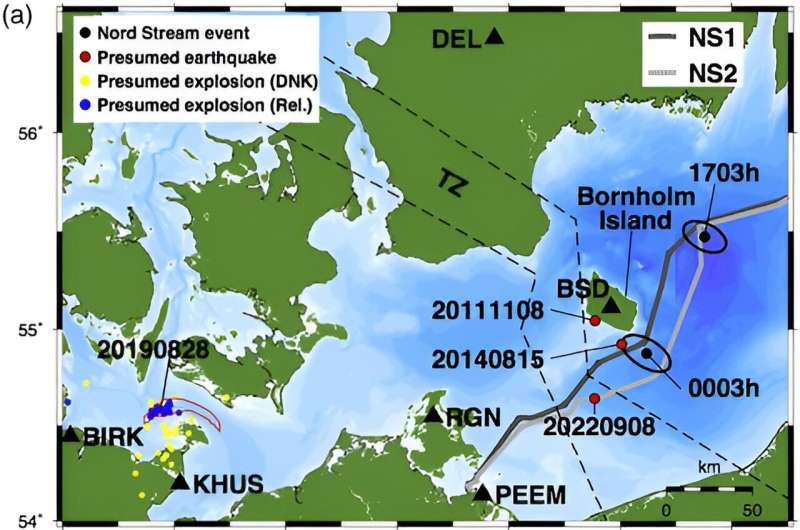(a) Map showing the locations of the two largest Nord Stream events and other events analyzed in this study. Locations of the presumed earthquakes are those published by the Geological Survey of Denmark and Greenland. Locations of the August 2019 undersea mine detonations in the Fehmarnbelt Nature Conservation Area (bounded by the red line) published by the Geological Survey of Denmark and Greenland (DNK), and relative locations estimated in this study (Rel.) are also displayed. The approximate extent of the Tornquist zone (TZ) is bounded by the dashed lines (after Hock et al., 2000). Seismic stations used in this study are shown as black triangles. (b) Map showing the locations of International Monitoring System (IMS) infrasound (pink triangles) and seismic (black triangles) stations used in this study and the two Reviewed Event Bulletin (REB) epicenters (red stars) for the Nord Stream events. The epicenter of the 7 October 2023 event and Finnish National Seismic Network (HE) stations (orange triangles) are also shown. (c) Map showing local distance stations used here and a comparison of REB epicenters and those estimated in this study. The approximate routes of the Nord Stream pipelines (NS1 and NS2) are shown along with the locations of observed gas leaks published in maritime navigational warnings. Credit: The Seismic Record (2024). DOI: 10.1785/0320230047
Seismic events that coincided with sudden drops in pressure within the Nord Stream 1 and 2 natural gas pipelines in September 2022 alerted the world to the rupture of pipelines in the western Baltic Sea. The suspected act of sabotage, which reportedly used explosive charges to rupture the pipelines, is still under investigation by multiple countries.
A new study published in The Seismic Record provides further evidence that the Nord Stream seismic signals came from a complex source. The signals lasted longer than would be expected from a single explosive source, the researchers say, and were more like the signals detected from an underwater volcano or a pipeline venting gas.
The initial signals from seismic events detected on September 26, 2022 "may be dominated by energy generated by the rapid venting of high-pressure gas, which means it may be difficult to assess the source size and characteristics of any explosive charges used to rupture the Nord Stream pipelines," said Ross Heyburn of AWE Blacknest.
The Nord Stream events offer a rare opportunity to study seismic and infrasound signals from the rupture of an underwater gas pipeline, Heyburn and colleagues noted. The researchers had access to data collected by local and regional seismic networks as well as seismic and infrasound data collected by the International Monitoring System (IMS), a global network that detects nuclear and other explosions for the Comprehensive Nuclear-Test-Ban Treaty Organization (CTBTO).
"To the best of our knowledge, this was the first time that the IMS has recorded signals from an underwater event associated with a gas pipeline rupture," Heyburn said. "The events therefore provided an opportunity to observe the characteristics of signals, such as the long durations, generated by this type of source."
Natural seismic activity in the region is low, but the research team was able to analyze the Nord Stream signals with the help of seismic data from a few small earthquakes and explosions detonated during a 2019 NATO operation in the region to clear World War II British ground mines.
One of the methods seismologists use to determine whether a seismic event is caused by an explosion or an earthquake is to measure the ratio of P to S waves for the event. Explosions usually have a higher ratio of P to S waves than earthquakes, and the Nord Stream events are very different to nearby earthquakes in this regard, the researchers concluded.
The spectra of seismic signals from underwater explosions sometimes display a series of modulations caused by interference between the primary pulse generated by the explosion and later pulses generated by the changing size of the gas bubble created by the explosion. Heyburn and colleagues did not observe this series of modulations clearly, which suggests a complex source rather than a simple explosion source for the Nord Stream events.
One of the most striking features of the Nord Stream events is its long-lasting seismic and infrasonic signals, the researchers found. These signals decay slowly over thousands of seconds—much longer than would be expected from an impulsive, single explosion event. For instance, the infrasound recorded in Southern Germany from the first Nord Stream event of 26 September lasted about 2,000 seconds, while an impulsive event recorded at that distance would normally last no longer than about 600 seconds.
These long-lasting seismic and infrasound signals are likely the result of vibrations caused by high-pressure gas venting rapidly from the pipeline into the water and atmosphere. The lengthy signals are similar to seismic signals caused by roaring flames when pipelines explode on land, Heyburn and colleagues concluded, noting that the duration of the Nord Stream infrasound signals was similar to those detected during venting by underwater volcanoes.
The researchers also compared the magnitude of the first Nord Stream pipeline seismic event to the magnitude of a seismic event on 7 October 2023 caused by the underwater rupture of the Balticconnector gas pipeline connecting Finland and Estonia. The Balticconnector pipeline rupture is thought to have been caused by a ship's anchor rather than an explosive charge.
The difference in seismic magnitudes between the two events "is consistent with the estimated potential energy ratio of the gas in each of these pipelines," Heyburn explained, which suggests that seismoacoustic signals from the initial Nord Stream event were dominated by the rapid venting of high-pressure gas.
More information: Ross Heyburn et al, The 26 September 2022 Nord Stream Events: Insights from Nearby Seismic Events, The Seismic Record (2024). DOI: 10.1785/0320230047
Provided by Seismological Society of America






















